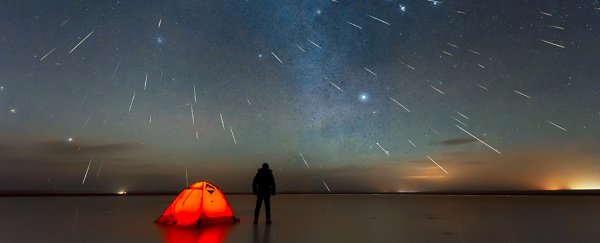Meteor showers are events seen from a planet's surface, where numerous meteors are seen within a short period of time radiating from roughly the same area of sky.
Like most typical meteors streaking through the night sky, those which are part of a meteor shower tend to consist of small pieces of mineral. They're often smaller than a grain of sand, burning brightly up as they pass through the atmosphere.
Where do meteor showers come from?
We see many meteor showers at specific times of the year thanks to Earth's orbit, which takes us through dense patches of dust as we circle the Sun.
These 'clouds' of dust motes and tiny grains of rock and ice are the debris shed by comets and asteroids that have crossed our path. Each time one of these large balls of rock and ice swings close to the Sun it loses a little more of its material in a stream of vapor, releasing the dust and grit trapped inside.
Since the majority of meteors seen in a meteor shower come from the same stream of particles, they all seem to rain down from one corner of the sky. The constellation that appears closest to where the meteor shower appears to be coming from when it's at its peak gives the annual event its name.
Astronomers use the term Zenithal Hourly Rate (ZHR) to describe the peak density of meteors that can be observed in an hour under perfect conditions.
When can I see a meteor shower?
While meteor showers are a predictable part of the astronomical time table, nature isn't always on our side. Not only can clouds ruin a good viewing, but a bright Moon, or even the timing of the rising and setting of the meteor shower's celestial coordinates can make them hard to see.
Variations in the density of the stream of dust we might happen to be passing through will also determine how many meteors we see each hour.
But if you're keen, these are the approximate timings of some of the best showers each year.
When is the next meteor shower?
In December to January …
The first of several big annual meteor showers in the Northern Hemisphere is called the Quadrantids, named after a demoted constellation once called Quadrans Muralis (now referred to as Boötes, because the namesake no longer exists.)
The nature of the rock that left this trail of debris is a bit odd, thought to be a 'rock comet' that orbits the Sun every five and a half years.
This shower is most active early January, with a ZHR of anywhere around 60 to 200.
In late April …
In mid to late April you'll be able to see the Lyrids, an ancient shower that was once a veritable storm of shooting stars. Today the shower has a rather low ZHR of roughly 20 to 100.
Left by Comet Thatcher C/1861 G1, it appears not too far from the constellation Lyra, known for one of the brightest of the stars in the sky, Vega. While it can be seen in the northern parts of the Southern Hemisphere, this meteor shower is really another Northern Hemisphere treat.
In April to May …
Finally a shower for those in the Southern Hemisphere! The Eta Aquarids rain down meteors at a rather modest ZHR somewhere in the dozens, with a peak of around 90 meteors per hour, lining up with the constellation Aquarius (which is somewhat higher in the sky for those south of the equator, giving a better shot at seeing a decent show).
This shower is a gift from Halley's Comet's journey back out into the Solar System's depths. Last visiting in 1986, it will hopefully top up this batch of space dust again in 2061.
In July to August …
The Perseids are almost guaranteed to put on a solid performance year after year, and are just the thing for spending a warm Northern Summer evening out on a blanket.
With a ZHR of between 60 to 80, there's a good chance you'll see at least a few good streaks streaming out of the constellation Perseus. If you're lucky, you might even see some meteors that glow brightly in a 'fireball'.
This shower was left by the passing of Comet Swift-Tuttle, which has an orbit of 133 years. It last visited in 1992, so we shouldn't expect to see it again until next century.
In October to November …
Halley's comet has a second yearly treat for stargazers in the form of the Orionids meteor shower. Sometime in October to early November, Earth slips through the trail of dust left by the comet's inbound journey.
It's not quite as exciting as its sister shower in May, with a ZHR of around 20, but they do tend to be quite bright as a result of their high speed. They're visible in both hemispheres as well, appearing not too far away from that famous big red star in the constellation Orion, Betelgeuse.
Can meteor showers do damage?
The vast majority of meteors burn up long before they hit the ground, posing no threat to property or people. Occasionally, a small amount of material survives entry into Earth's atmosphere and explodes above the planet's surface.
If the material from a meteor falls to Earth, it's known as a meteorite. There are some reports each year of meteorites doing damage to property, and there has been one reported death due to a meteorite.
All Explainers are determined by fact checkers to be correct and relevant at the time of publishing. Text and images may be altered, removed, or added to as an editorial decision to keep information current.
